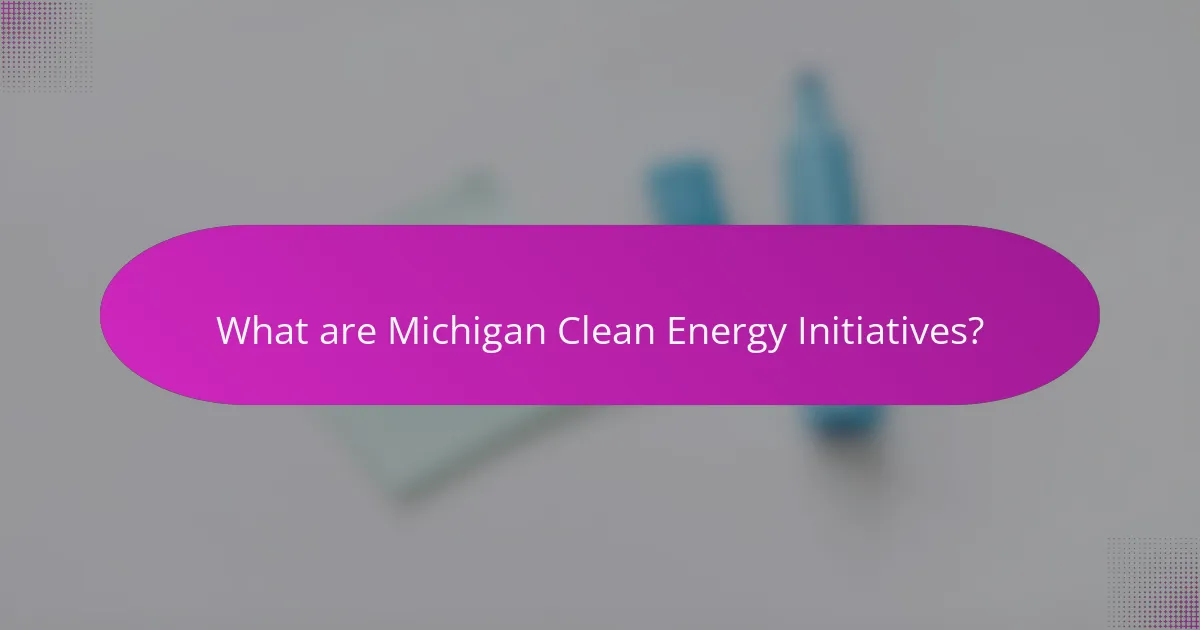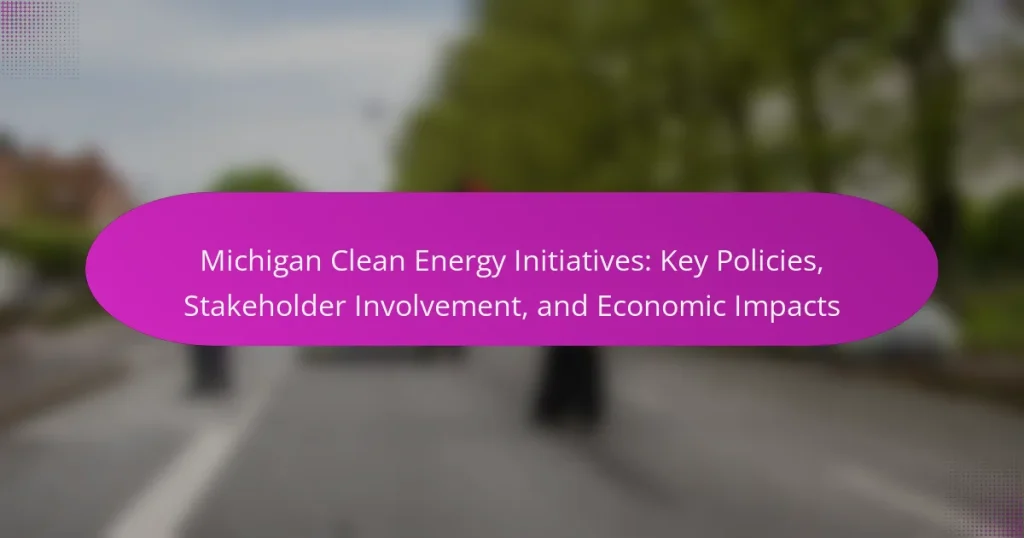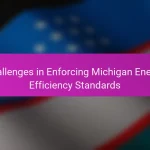
What are Michigan Clean Energy Initiatives?
Michigan Clean Energy Initiatives are programs and policies aimed at promoting renewable energy and energy efficiency in the state. These initiatives include the implementation of the Clean and Renewable Energy Standard. This standard mandates that a certain percentage of electricity sold in Michigan must come from renewable sources. Additionally, the initiatives support energy efficiency programs to reduce overall energy consumption. The state has set a goal to achieve 15% energy savings by 2021. These efforts are part of a broader strategy to combat climate change and enhance energy security. Michigan’s Clean Energy Initiatives also involve stakeholder engagement, including utilities, businesses, and environmental groups. They aim to create a sustainable energy future while boosting the local economy.
How do these initiatives align with national energy goals?
Michigan’s clean energy initiatives align with national energy goals by promoting renewable energy sources and reducing greenhouse gas emissions. These initiatives aim to increase the use of solar, wind, and other renewable technologies. The state’s commitment to achieving 50% renewable energy by 2030 supports the federal goal of transitioning to a cleaner energy economy. Additionally, Michigan’s efforts to enhance energy efficiency contribute to national targets for reducing overall energy consumption. The integration of electric vehicles into the energy landscape aligns with the national agenda to reduce reliance on fossil fuels. Overall, Michigan’s clean energy policies reflect a strategic alignment with the broader objectives of sustainable energy development and climate action at the national level.
What specific policies define Michigan’s clean energy approach?
Michigan’s clean energy approach is defined by several key policies. The 2008 Energy Optimization Standard mandates energy efficiency measures for utilities. The 2016 Clean Power Plan aimed to reduce carbon emissions from power plants. Additionally, the 2019 Energy Law promotes renewable energy sources and sets a goal of 50% renewable energy by 2030. The state also supports community solar programs and energy storage initiatives. These policies collectively aim to enhance sustainability and reduce reliance on fossil fuels.
How do these policies impact renewable energy adoption?
Policies significantly enhance renewable energy adoption in Michigan. They provide financial incentives, such as tax credits and rebates, which lower the cost of renewable energy technologies. These incentives encourage both businesses and consumers to invest in solar, wind, and other renewable sources. Additionally, state mandates for renewable energy standards require utilities to generate a specific percentage of their energy from renewable sources. This creates a market demand for renewable energy projects. Research shows that states with strong renewable energy policies see higher rates of adoption. For example, Michigan’s renewable energy capacity increased by over 100% between 2012 and 2020 due to supportive policies. Overall, effective policies create a favorable environment for renewable energy growth.
What role do stakeholders play in Michigan’s clean energy initiatives?
Stakeholders play a crucial role in Michigan’s clean energy initiatives. They include government agencies, utility companies, non-profit organizations, and community groups. These entities collaborate to develop policies and programs that promote renewable energy sources. For example, the Michigan Public Service Commission oversees regulatory frameworks that support clean energy adoption. Utility companies invest in infrastructure for solar and wind energy. Non-profit organizations advocate for environmental sustainability and educate the public. Community groups often participate in local energy projects, ensuring that initiatives reflect local needs. This collaborative approach helps Michigan achieve its clean energy goals effectively.
Who are the key stakeholders involved in these initiatives?
Key stakeholders involved in Michigan Clean Energy Initiatives include government agencies, utility companies, and non-profit organizations. Government agencies such as the Michigan Department of Environment, Great Lakes, and Energy play a crucial role in policy formulation. Utility companies like DTE Energy and Consumers Energy are essential for implementing clean energy projects. Non-profit organizations advocate for sustainable practices and community engagement. Additionally, local communities and residents are stakeholders, as they are directly affected by energy policies. Businesses and industry groups also participate, seeking to influence energy regulations and benefit from clean energy investments.
How do stakeholder collaborations shape policy development?
Stakeholder collaborations shape policy development by integrating diverse perspectives and expertise into the decision-making process. These collaborations foster dialogue among government entities, businesses, and community groups. They help identify shared goals and concerns, which can lead to more comprehensive policies. For instance, in Michigan’s clean energy initiatives, stakeholders such as utility companies and environmental organizations contribute valuable insights. This input can enhance the effectiveness and acceptance of policies. Research shows that collaborative approaches often result in more sustainable and equitable outcomes. Studies indicate that policies developed through stakeholder engagement are more likely to be implemented successfully.
What are the economic impacts of Michigan’s clean energy initiatives?
Michigan’s clean energy initiatives have led to significant economic impacts. These initiatives have created thousands of jobs in renewable energy sectors. For example, the Michigan Energy Innovation Business Council reported over 100,000 jobs in clean energy by 2020. Investment in clean energy has also attracted over $1 billion in private funding. This funding supports solar, wind, and energy efficiency projects. Clean energy initiatives have reduced energy costs for consumers and businesses. The state aims to achieve a 50% reduction in greenhouse gas emissions by 2030. This goal encourages further investment and innovation in the clean energy sector. Overall, Michigan’s clean energy initiatives contribute to economic growth and sustainability.
How do these initiatives affect job creation in Michigan?
Michigan’s clean energy initiatives significantly boost job creation. These initiatives lead to investments in renewable energy projects, such as wind and solar. According to the Michigan Energy Innovation Business Council, the clean energy sector has created over 100,000 jobs in the state. This includes roles in manufacturing, installation, and maintenance of renewable energy systems. Additionally, policies promoting energy efficiency have resulted in further job opportunities in retrofitting and energy auditing. The state’s commitment to reducing carbon emissions also encourages innovation and entrepreneurship, fostering new businesses that contribute to the job market.
What are the cost savings associated with clean energy adoption?
Clean energy adoption leads to significant cost savings for consumers and businesses. Transitioning to renewable energy sources reduces reliance on fossil fuels. This shift lowers energy bills due to decreasing operational costs. For instance, the levelized cost of solar energy has dropped by 89% since 2009. Wind energy costs have fallen by 70% in the same period. Additionally, clean energy sources often incur lower maintenance costs compared to traditional power plants.
Investing in energy efficiency measures can further enhance savings. Programs aimed at improving energy efficiency can reduce energy consumption by up to 30%. Furthermore, clean energy adoption can stimulate job creation in the renewable sector. According to the U.S. Department of Energy, over 3 million jobs were created in the clean energy sector by 2020.
Overall, the financial benefits of adopting clean energy solutions are substantial and contribute to long-term economic stability.
How are Michigan’s clean energy initiatives funded and supported?
Michigan’s clean energy initiatives are funded and supported through a combination of state policies, federal grants, and utility investments. The state has established a Renewable Portfolio Standard, requiring utilities to obtain a percentage of their energy from renewable sources. This policy incentivizes investment in clean energy projects. Federal funding also plays a crucial role, with grants available through programs like the Department of Energy’s Solar Energy Technologies Office. Additionally, utility companies in Michigan invest in renewable energy infrastructure and energy efficiency programs. The Michigan Public Service Commission oversees these initiatives, ensuring compliance and progress towards clean energy goals.
What financial mechanisms are in place for clean energy projects?
Clean energy projects utilize various financial mechanisms to secure funding. These mechanisms include grants, loans, tax credits, and public-private partnerships. Grants provide direct funding without repayment obligations. Loans offer capital with repayment terms, often at favorable interest rates. Tax credits reduce the tax burden, incentivizing investment. Public-private partnerships leverage resources from both sectors for project development. Additionally, renewable energy certificates can generate revenue for projects. These financial tools are crucial for the viability and expansion of clean energy initiatives in Michigan.
How do state and federal incentives support these initiatives?
State and federal incentives significantly support Michigan’s clean energy initiatives. These incentives include tax credits, grants, and rebates aimed at promoting renewable energy projects. For instance, the federal Investment Tax Credit (ITC) offers a 26% tax credit for solar energy systems installed before 2023. Additionally, Michigan’s Renewable Energy Standard mandates that 15% of electricity must come from renewable sources by 2021, fostering investment in clean technologies. These policies stimulate job creation and economic growth in the clean energy sector. According to the Michigan Energy Innovation Business Council, the clean energy sector has created over 100,000 jobs in the state.
What challenges do Michigan’s clean energy initiatives face?
Michigan’s clean energy initiatives face several significant challenges. One major challenge is the regulatory framework that can hinder project implementation. Complex permitting processes often delay the development of renewable energy projects. Additionally, funding and financial support for clean energy projects can be inconsistent. This inconsistency affects the overall investment climate in the state.
Market competition from traditional energy sources also poses a challenge. The established fossil fuel industry often has lower operational costs. Furthermore, public awareness and acceptance of clean energy technologies can be limited. Many residents may not fully understand the benefits of transitioning to renewable sources.
Lastly, infrastructure limitations can restrict the integration of renewable energy into the grid. Upgrading the grid to accommodate new technologies requires significant investment and planning. These challenges collectively impact the effectiveness and progress of Michigan’s clean energy initiatives.
What barriers hinder the implementation of clean energy policies?
Barriers hindering the implementation of clean energy policies include financial constraints, regulatory challenges, and lack of public support. Financial constraints arise from the high initial investment required for clean energy infrastructure. Regulatory challenges often involve complex permitting processes and inconsistent policies across different jurisdictions. Lack of public support can stem from misinformation about clean energy benefits and concerns over job losses in traditional energy sectors. According to a report by the International Renewable Energy Agency, 70% of stakeholders cite financial barriers as a major obstacle.
How can these challenges be overcome for future success?
Engaging stakeholders effectively can overcome challenges in Michigan’s clean energy initiatives. Building strong partnerships with local communities fosters collaboration and trust. Educating the public about clean energy benefits increases support and participation. Implementing clear policies and regulations streamlines project development processes. Securing funding through state and federal programs enhances resource availability. Regularly assessing and adapting strategies ensures alignment with evolving energy needs. These approaches have been successful in various states, demonstrating their potential for Michigan’s future success.
What best practices can be learned from Michigan’s clean energy initiatives?
Best practices from Michigan’s clean energy initiatives include stakeholder collaboration, policy transparency, and investment in renewable technologies. Stakeholder collaboration ensures diverse input and support for initiatives. For example, Michigan’s partnerships with utility companies and community organizations enhance project effectiveness. Policy transparency fosters trust and accountability among stakeholders. This is evident in the state’s clear communication of goals and progress. Investment in renewable technologies, such as wind and solar, drives economic growth and job creation. Michigan’s clean energy sector has seen significant job increases, with over 100,000 jobs reported in 2021. These practices create a sustainable framework for future energy initiatives.
How can other states replicate Michigan’s success in clean energy?
Other states can replicate Michigan’s success in clean energy by adopting similar policies and stakeholder engagement strategies. Michigan has implemented renewable energy standards that mandate a specific percentage of energy to come from renewable sources. States should establish clear, enforceable renewable energy targets to drive investment. Additionally, fostering collaboration among government, utilities, and private companies has been crucial in Michigan. Engaging diverse stakeholders ensures shared goals and resources.
Financial incentives, such as tax credits and grants for clean energy projects, have also played a significant role in Michigan’s success. States should consider similar financial mechanisms to stimulate growth in the clean energy sector. Furthermore, investing in workforce development programs can prepare local workers for jobs in renewable energy. Michigan’s focus on education and training in this field has helped create a skilled workforce.
Lastly, monitoring and evaluating progress is essential. Michigan regularly assesses its clean energy initiatives to ensure they meet set goals. Other states should adopt a similar approach to track their advancements and make necessary adjustments.
What lessons have been learned from stakeholder engagement?
Stakeholder engagement has revealed several critical lessons in Michigan’s clean energy initiatives. Effective communication fosters trust and collaboration among stakeholders. Engaging diverse groups leads to more comprehensive policy development. Stakeholders often provide valuable insights that enhance project outcomes. Consistent feedback loops are essential for adapting strategies and addressing concerns. Transparency in decision-making builds credibility and support for initiatives. Lastly, sustained engagement strengthens community ties and promotes long-term commitment to clean energy goals. These lessons are supported by successful case studies from Michigan’s various clean energy projects.
Michigan Clean Energy Initiatives encompass programs and policies designed to promote renewable energy and enhance energy efficiency within the state. Key components include the Clean and Renewable Energy Standard, which mandates a specific percentage of electricity from renewable sources, and various stakeholder collaborations that engage utilities, businesses, and environmental groups. These initiatives aim to achieve significant energy savings, align with national energy goals, and drive economic growth by creating jobs in the clean energy sector. The article will explore the specific policies that define Michigan’s approach, the role of stakeholders, the economic impacts, and the challenges faced in implementing these initiatives.


